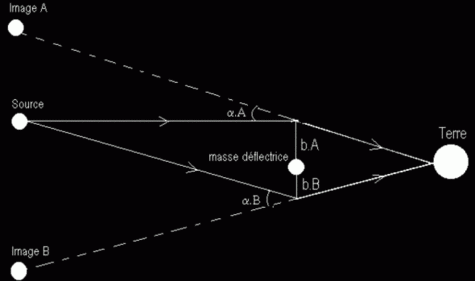-
 Macroalgae
Macroalgae
-
 Pike
Pike
-
 Western Palearctic ecozone
Western Palearctic ecozone
-
 Specific impulse
Specific impulse
-
 Vacuole
Vacuole
-
 Model organism
Model organism
-
 Reach
Reach
-
 Nucleotide
Nucleotide
-
 Die
Die
-
 Protrusion
Protrusion
-
 Cerebrospinal
Cerebrospinal
-
 Antibiotic resistance
Antibiotic resistance
-
 Granulite
Granulite
-
 Cuculiformes
Cuculiformes
-
 Dysuria
Dysuria
-
 Acupressure
Acupressure
-
 Fine structure constant
Fine structure constant
-
 Graphics software
Graphics software
-
 ppm
ppm
-
 Alphamosaic
Alphamosaic
-
 Tubercle
Tubercle
-
 Antibodies
Antibodies
-
 Brute force
Brute force
-
 Decarbonation
Decarbonation
-
 Senescence
Senescence
-
 Amorphous
Amorphous
-
 Oxidase
Oxidase
-
 ASCII
ASCII
-
 Colposcopy
Colposcopy
-
 Guttation
Guttation
Gravitational lens
One of the first phenomena predicted by general relativity, and which greatly contributed to its acceptance, was the diversion of light, also known as "gravitational lensing". In the neighbourhood of a black hole this phenomenon is extremely strong, but it is not this which is the best evidence for their existence. In fact, active black holes surrounded by large quantities of matter may be the easiest to observe, but around them the diversion of light is difficult to show because of the accretion disk and the complexity of the emitted radiation.
Historical perspective
Einstein, in his theory of general relativity, told us that light rays are diverted near massive objects.
• In a similar fashion to how an image is deformed when light rays are diverted by a glass lens in their path, it should be expected to observe a deformed image of stars when there is a massive object such as a black hole or a galaxy in their direction.
• The theory was first experimentally tested in 1919. During a solar eclipse, Arthur Eddington observed a star that is normally located behind the Sun. The measurement of the diversion confirmed Einstein's predictions. The Sun was causing the first observed gravitational mirage.
• In 1937 Einstein returned to the subject describing Einstein's rings: when two sufficiently distant stars are aligned with the Earth, the furthest star, the source, is seen as a ring surrounding the nearer star, which is called a gravitational lens. When the source is only slightly offset from the Earth-lens axis, multiple images of the source can be observed.
 A simple model of a gravitational lens: the observer sees 2 main images of the source on either side of the lens (the deflecting mass). The alpha angle of diversion is 4G.M/(b.c²).
A simple model of a gravitational lens: the observer sees 2 main images of the source on either side of the lens (the deflecting mass). The alpha angle of diversion is 4G.M/(b.c²).
Latest
Fill out my online form.



